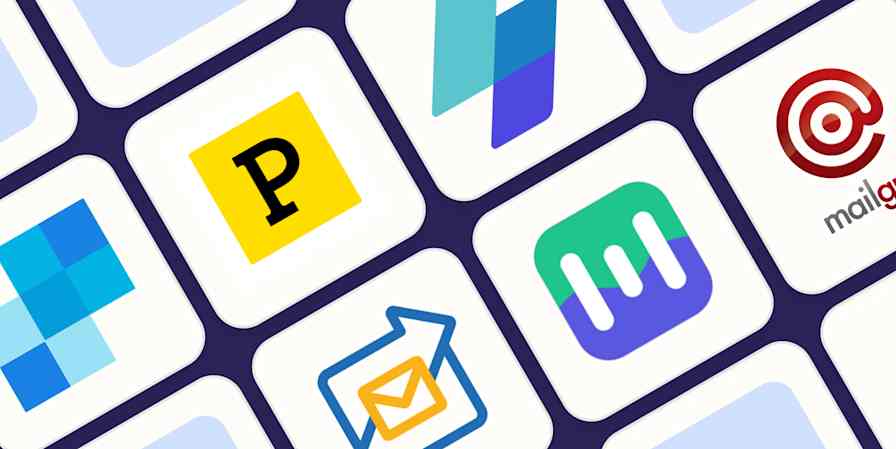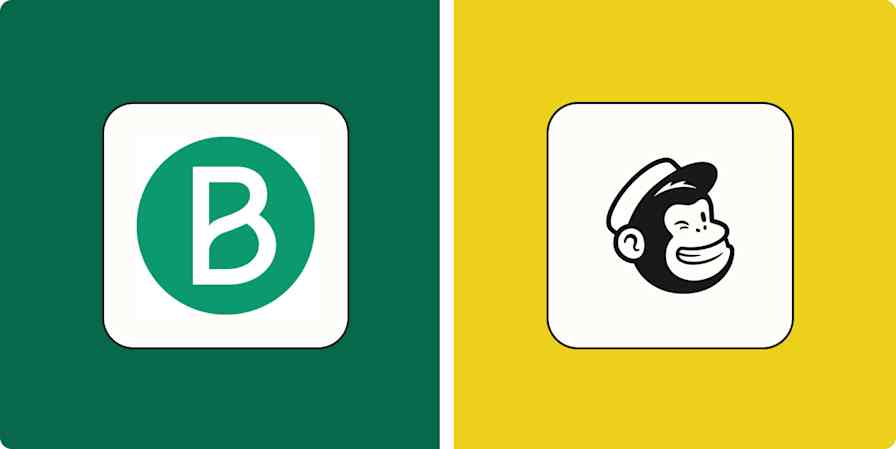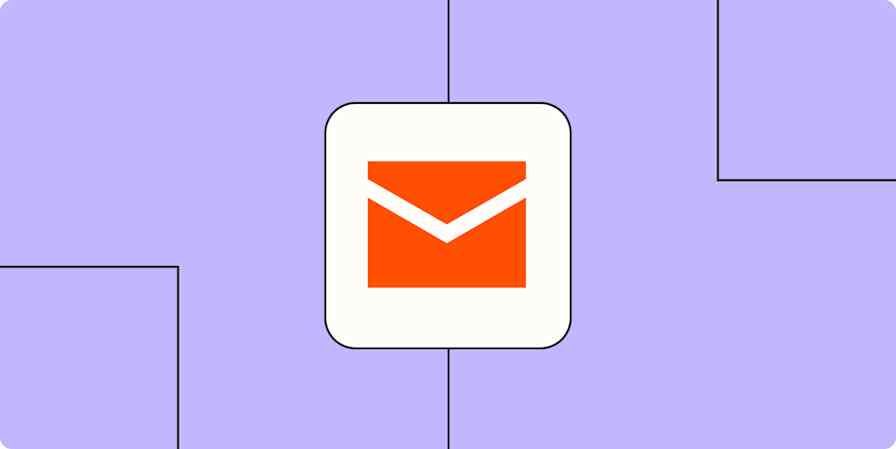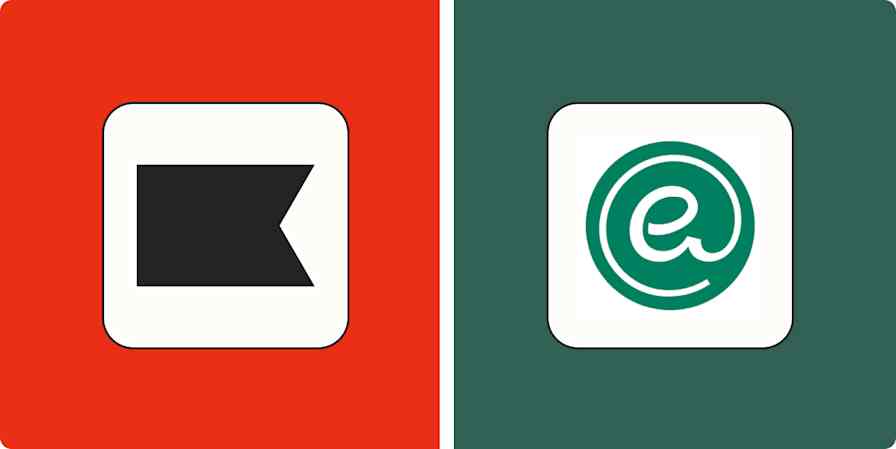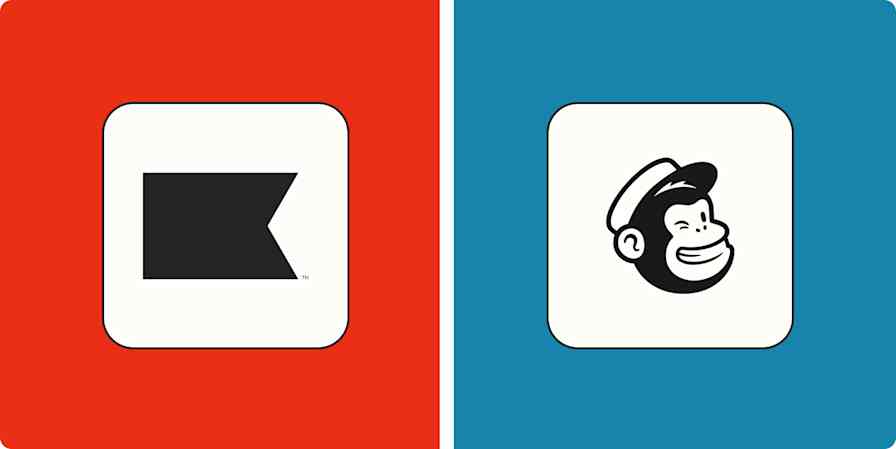I'd been working in email marketing for quite a while before I took on my first B2B campaign. Of course, I knew that B2B campaigns needed to be handled differently than my usual consumer outreach, and I thought I'd made the necessary tweaks.
What I didn't realize is that minor tweaks to generalized email marketing tactics aren't enough to create a successful B2B campaign. If you're a beginner learning the ropes or a veteran B2C marketer making the shift, trying to work with anything other than a purpose-built B2B marketing strategy is a recipe for disaster.
I learned from my B2B blunder, and in an effort to save other marketers from similar mistakes, I've put together a guide to building a tailored B2B email marketing strategy.
Table of contents:
What is B2B email marketing?
B2B email marketing is a tactic for promoting products or services to business-to-business customers. At its core, the goal is to nurture relationships with potential customers, build brand awareness, and generate sales. Successful strategies involve distributing newsletters, promotional offers, product updates, or free tools—all hyper-tailored to the needs and interests of the recipient.
When done right, B2B email marketing provides valuable information that encourages the recipient to make a purchase or take another desired action to move through the marketing funnel.
Why do B2B emails require B2B strategies?
General email marketing tactics don't work for B2B campaigns for the same reason two nearly identical doors still require different keys: you're trying to get different people in the door.
Here are a few specific ways B2B campaigns require different tactics than general email marketing campaigns.
Email targeting: Businesses vs. consumers
Most email marketing campaigns target individuals, but B2B campaigns target companies—or rather, multiple individuals at a company. Whereas an individual getting a B2C email is responsible for every stage of their own buying journey, a company's purchasing process involves people in all sorts of roles.
When you identify a B2B target, you're really identifying a group of targets—and your B2B online marketing strategy needs to account for the differences among multiple contacts within a company.
What this means in practice: To reach people effectively, you need to be sending different emails to different individuals within the same target company.
Longer sales cycles
Buying something on your own doesn't take very long. To paraphrase one of my favorite Ariana Grande songs: you see it, you like it, you want it, you got it. Easy. (In my case, there's usually also a "you check your bank balance" somewhere in there, but that's a bit of a mouthful for a pop lyric.)
For a company, on the other hand, the purchasing process can be a lot like herding cats. Getting multiple departments to coordinate on a decision, especially one that requires a budget approval, takes a Herculean effort—and Herculean patience.
What this means in practice: Since email marketing campaigns last the length of the customer journey, expect your marketing cycles for B2B companies to take a lot more time.
Resource-rich content
Consumers know that they're consumers, so when you're writing B2C emails, you can be more obvious about the fact that you're trying to make a sale. Content like promotions, discounts, and sale announcements fit in a B2C campaign but would feel strange in an email to a business.
B2B emails tend to perform better when they focus on providing information and resources. Educational content like trend reports, industry benchmarks, how-to guides, and webinar recordings help prove your brand's value to a B2B subscriber.
What this means in practice: You'll need to source entirely new content types and formats to use for your B2B campaigns—repurposing B2C content is out of the question.
8 key strategies for designing a B2B email campaign
You get it: B2C or generalized email strategies are a no-go for your B2B campaign. But telling you what tactics not to use without giving you any to replace them wouldn't be very helpful of me, would it? Here's how to nail your B2B email marketing campaign.
1. Profile your target customers
When targeting a particular B2B company, you're really targeting that company's buying center—the group of people who determine whether or not the company purchases your product.
The buying center includes six main roles:
Initiators are the first people at a company who become introduced to and interested in your product.
Users are the people who will use your product day-to-day once the company decides to make the purchase.
Buyers are the people who handle the logistics and administrative aspects of a potential purchase, including budgeting, contract terms, renewals, etc.
Deciders are the people who ultimately decide whether or not to approve the buyers to move forward with a purchase.
Gatekeepers are the people (usually administrators) who control the flow of information to and from other members of the buying center.
Influencers is a catch-all group that encompasses anyone within an organization that influences the decisions and opinions of other members of the buying center (this might end up being literally everyone else at the company).

If you've done any marketing in the past, you may be familiar with the ideal customer profile (ICP), or the audience vignette created by outlining your prospective customers' demographics, behaviors, characteristics, challenges, and needs. Your B2B targets are groups, so you'll need to expand your ICP to incorporate different columns for each different role in the target company's buying center.
2. Think like a buyer
With a customer profile matrix in hand, you can step into the mindset of each member of your target customer's buying center in order to better understand what kinds of emails fit each role.
For example, an initiator or a user will likely be interested in a how-to guide that relates to an aspect of the user's job. If you sent that same email to a buyer, who primarily deals with the purchasing and renewal of a product rather than its actual function, it would probably get sent straight to the trash.
The more customized your emails are to your targets' actual needs, the more effective they'll be—and the fewer unsubscribes or spam reports you'll get.
3. Use email segmentation and personalization
When I'm running campaigns at scale, the thought of tailoring my emails to each individual at a company would send me running for the hills.
Email segmentation tools (which are built into most email marketing platforms) allow you to group your subscribers according to their characteristics. Instead of grouping contacts by company or industry, create lists for each of the different buyer personas. With as few as six segmented lists, you can hit everyone on your target list with content that's customized to their interests and needs.
Personalization is the next step in segmentation and ratchets the power of your campaign up a notch by getting a little more human. It's just psychology: when you tailor the content within each segmented campaign to individuals, those individuals are more likely to take the desired action.
Job title, past interactions, or specific interests are all elements you can dynamically adjust in subject lines, introductory greetings, or content focus, to say exactly what a given person needs to hear at a given moment. This ensures that even within a broad (and rather boring-sounding) segment like "Marketing managers at SaaS companies," each individual receives an email that directly speaks to their unique situation—and the unique problems they need to solve.
4. Map your campaign to the buyer's journey
The B2B email marketing cycle should more or less mirror the B2B customer journey. By planning your campaign around the stages of the customer journey, you can ensure that your emails are relevant not only to who your target is, but also to where they are at a particular point in time.
There are five main stages of the buyer journey, and different types of content are best suited to each stage.
Awareness: The target is learning about your brand and product but isn't seriously thinking about making a purchase yet. How-to guides, eBooks, thought leadership, and other educational content can help the target grow familiar with your brand.
Consideration: The target is specifically interested in your product, but won't reach the decision-making stage until they've gathered more information. Case studies, customer testimonials, and product demos can provide more information about your product's value and push the target toward making a purchase.
Decision-making: The target is interested in buying or trying your product, and is now considering things like budget and return on investment in order to determine whether they're ready to buy. Free trials, discount offers, and cost estimates can influence your target in the direction of a purchase.
Retention: Once your prospect is a customer, your goal is for them to buy more of your product, renew their subscription, or otherwise continue your customer relationship. Product tutorials and high-level educational content can help your target get the most out of your product's features and encourage them to remain a customer.
Advocacy: Targets who are loyal customers can help boost your marketing efforts by becoming brand advocates—they'll tell others about your product and bring in new targets. Surveys and referral program offers can engage customers in more active brand advocacy.

5. Use templates
Email templates are another valuable tool to keep in your work-smarter-not-harder toolbox. Building a solid library of high-quality, user-friendly, and scannable templates takes time, but you'll thank yourself later when you're able to crank through hundreds of emails in a day and still clock out by five.
The key to using templates is that the email recipient shouldn't be able to tell it's a template. Build a library of templates for each different type of email that you typically send, using the same brand elements across the board but ensuring each template is still visually distinct. Each of my campaigns has a different template for:
Thank-you emails
Survey emails
Curated content roundup emails
Newsletter and what's new emails
Educational and thought leadership emails
Case study and report emails
Event and webinar emails
Unsubscribe emails
Maintaining a template library will not only simplify your process, but it also ensures that you can take time off with the peace of mind that whoever fills in for you will have beautiful pre-made email skeletons ready to go.

6. Save time by automating
Email marketing automation allows you to complete detailed tasks that would be impossibly time-consuming to do manually.
For example, you might set up an automation that tags email contacts with any new information you receive about them, like demographic details and job characteristics. With a robust tagging system, you can target hyper-specific audiences like "female executives in the biotech industry" or "past attendees in the Los Angeles area" with just a few sort filters.
Your email marketing platform's sequencing function will also allow you to set up drip campaigns to be sent out over a period of weeks. That's a pretty common example, but there are plenty of others as well:
Add and update contacts based on form submissions on your website.
Segment your subscribers into different lists based on their behaviors (e.g., event attendance).
Send colleagues relevant updates about new subscribers, email lists, and sales leads.
Much like my template library, my email marketing automations let me sleep well knowing that things are running smoothly without my human brain.
And if you want to automate across apps, use Zapier to create entire integrated workflows. Learn more about how to automate your email marketing across your tech stack, or get started with one of these pre-built workflows.
Send emails via Gmail when Google Sheets rows are updated
Send Microsoft Outlook emails for new Typeform entries
Add or update ActiveCampaign contacts with new Facebook Lead Ads leads
Zapier is the most connected AI orchestration platform—integrating with thousands of apps from partners like Google, Salesforce, and Microsoft. Use interfaces, data tables, and logic to build secure, automated, AI-powered systems for your business-critical workflows across your organization's technology stack. Learn more.
7. Use AI for email marketing
It's increasingly important to establish an AI marketing plan, and that goes for B2B marketing efforts, too. Here are some ways you can use artificial intelligence within your email marketing software to smarten up your B2B campaigns:
Text generation: AI writing generators now go beyond basic copy. They can be deeply trained on your brand's content library to consistently replicate your unique voice, tone, and style across all email sequences, website copy, and even long-form content. Just be sure a human is the final eyes.
Translation: Many AI writing tools can also translate messages to different languages and even use natural language processing to account for not just regional dialects and slang but also cultural nuances, business etiquette, and industry-specific terminology in target languages.
Optimized subject lines: If you struggle to come up with a gripping subject line, you can use AI text generators or AI chatbots to test out alternate phrasing that fits within a strict character count.
Automated campaigns: When in doubt, just hand the whole operation over to the robots. AI sales assistant tools like Postaga can automate entire outreach across multi-channel campaigns for you. And nearly all marketing automation software is incorporating AI into its optimization. Mailchimp, for example, has AI-powered customer journeys.
Lead scraping: Not sure who to reach out to at a company? AI apps like Clay can instantly scrape the web for information, including company news, social media activity, technology adoption, and intent signals, to identify high-potential leads and prioritize accounts based on their likelihood to convert.
8. Refine strategies with A/B testing
A/B testing—enhanced by AI—helps you optimize all types of email marketing. Instead of broad throw-spaghetti-at-the-wall tests, A/B tests focus on tailoring variations of headlines, email content, send times, and calls to action to resonate with different B2B audience groups based on their industry, role, and company needs. Run those tests side by side, and see which one performs better—then rinse and repeat.
The benefits of A/B testing include:
Improved open rates: By testing different subject lines and send times, you can identify the combinations that are most likely to capture the attention of your target audience and entice them to open the email.
Increased CTR: Through testing variations of email content and CTAs, you can determine the messaging and design elements that are most effective in driving recipients to click on links and take the desired action.
Higher conversion rates: By optimizing the entire email experience through A/B testing, you can guide recipients toward conversion, whether that's making a purchase, signing up for a webinar, or requesting a demo.
Data-driven decisions: A/B testing provides concrete data on what works and what doesn't, enabling you to make informed decisions about your email marketing strategies and allocate resources effectively.
Continuous optimization: By continually testing and refining emails, you can make sure your email marketing efforts remain effective over time.
To actually conduct A/B testing, begin by selecting a single email element for testing, such as the subject line or a call-to-action button. (To get relevant data, it's important not to change too much at once.) The change could be as simple as adding a cupcake emoji to the subject line to see whether that prompts more opens.
Once you've got two mostly-the-same-but-actually-not emails, divide your email list into segments and send each segment a different version. Then, monitor the performance of each version to see whether your cupcake helps or hurts open rates. After the test, identify the higher-performing variation, and make the winner your go-to version for all future iterations of that email.
9 B2B marketing email examples that stick the landing
I get a lot of emails at work from B2B brands, many of which I subscribed to on purpose. For at least the first few emails, though, I'm evaluating them to decide whether I want to unsubscribe or if this brand's content is worth reading. Just because a brand is great doesn't mean their emails will be—there are plenty of companies killing it on the stock exchange but floundering in my inbox.
Remember that you're not just looking to get your recipients to click through, download, or register in the short term. You're also looking to prove that your content is valuable, well-curated, and pristinely presented so that your recipients want to see what's inside the next email you send.
Here are a few B2B emails that I've received personally that not only got me to open them but also impressed me with what I found inside.
1. New user email: Smartsheet
Buyer persona: User
Journey stage: Retention
It's essential to communicate to your recipients that you're not wasting their time. New users are beyond the purchasing stage of the buyer journey, so you're at risk of losing their engagement if they decide they no longer find your emails useful. The first emails after a company buys your product need to prove to them that your emails have a clear value-add and are worth opening.
Smartsheet's new user email uses large photos and minimal text to convey to the recipient that they're sending over useful resources and nothing else—as a project management and time tracking tool, their brand knows more than most how little time business people have for cold emails.
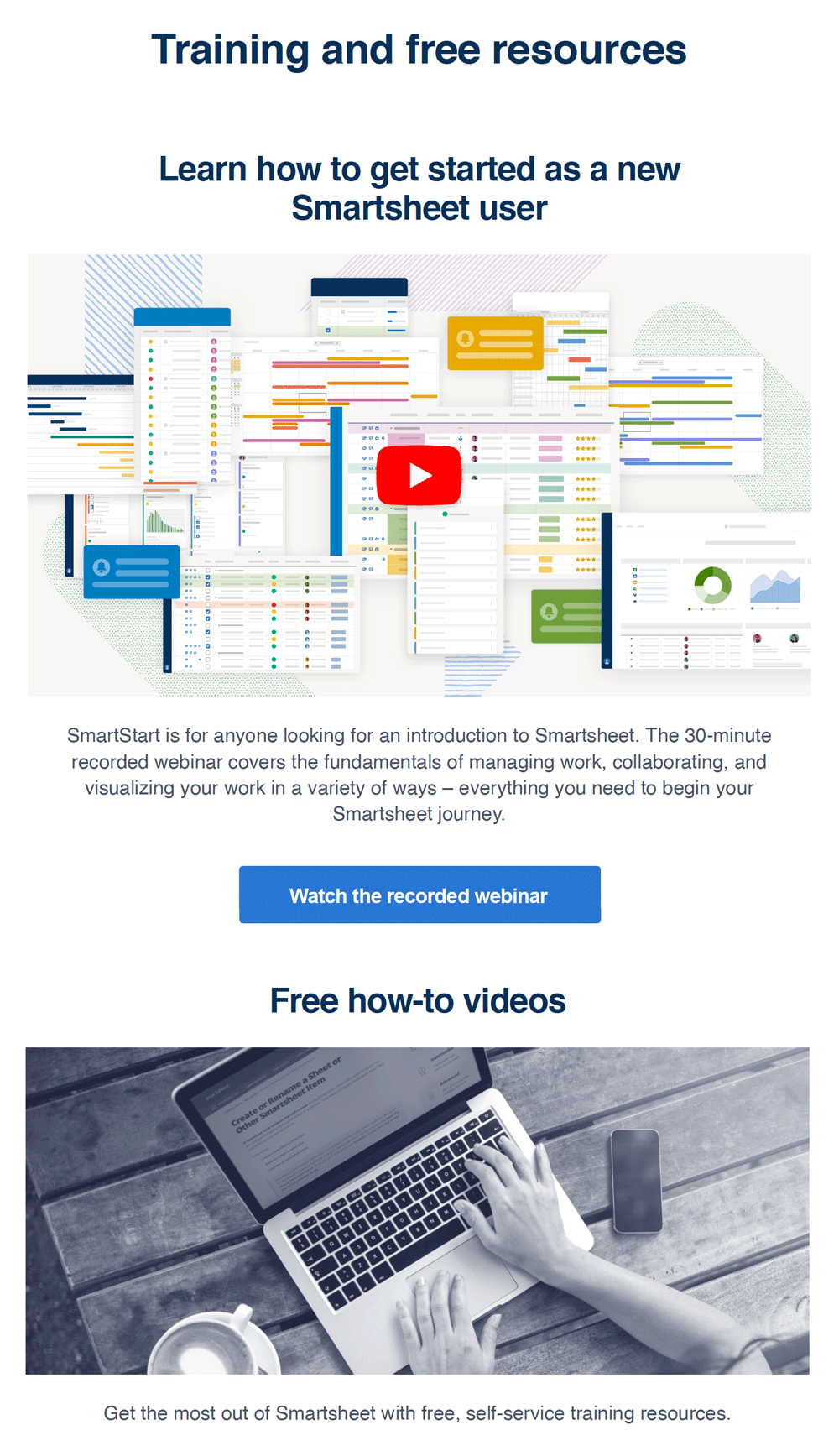
Using design to clearly title, subtitle, and attach images to your emails will ensure that people's eyes are drawn exactly what you want them to see, as soon as they open your email.
2. "What's new" email: Datawrapper
Buyer persona: User, Influencer
Journey stage: Awareness, Retention
Company updates are the email equivalent of someone walking up to your desk and starting to talk about themselves. If you have the time, and you're in the mood for a chat, that can be a perfectly lovely way to start a conversation. But if not, you're not only going to dismiss that person in the moment, but you're also going to start avoiding them whenever you have work to get done.
The key to update emails is to clearly tie your bits of news to things that directly impact the user (or potential user). For example, Datawrapper's company update leads with a new dark mode feature rollout for their platform. This is both a company update and a product update, which helps readers see the value of the email up front and encourages them to keep reading.

3. Download delivery email: Gallup
Buyer persona: Initiator, User
Journey stage: Awareness, Consideration
When I request a download from a website, it's usually a report or dataset that I need for a project I'm working on. I'm almost always in the middle of my workflow when I submit a download request, so when the email arrives, I have zero interest in doing anything except downloading what I need and moving on.
The only thing that could catch my attention while I'm in that flow is something else that could help me with the task at hand. The Gallup email below is one extremely rare example of a content download email that actually got me to open another piece of content that I didn't specifically ask for.

I downloaded this State of the American Manager report while working on a piece about business operations and people management, so when I saw a link to a resource on how to "transform your outdated performance management practices," I clicked—the topic seemed like it held pertinent information that could be valuable for my project.
When you're sending any B2B email, put yourself in the mindset of the person you're sending it to. For downloads and other emails that are designed to arrive at a particular point in time, give them what they want and not much else.
4. Live event and webinar email: SlashNext
Buyer persona: User, Buyer, Influencer
Journey stage: Awareness, Consideration, Decision-Making
If I ever got a physical invitation that included long paragraphs about the history of the event, the host's backstory, and a few other topics only vaguely related to the event itself, the invitation would be in the garbage before I even got to reading the date. You don't clutter your mailed invitations with a bunch of unnecessary information, so don't do it to your emailed invitations, either.

Of course, when you're cold emailing invitations, you do need to at least explain what the event is and why someone might be interested in attending it. Take a page from SlashNext's book—their invitation makes the most of a small amount of space by including a bulleted list of actionable information that attendees will hear during the webinar, but it doesn't extend beyond two paragraphs total, so it still feels light and efficient.
5. Trend report email: Exploding Topics
Buyer persona: Influencer, Initiator
Journey stage: Awareness, Consideration, Decision-Making
Trend reports are, by definition, cutting-edge. Though gimmicks are usually a big red flag in B2B emails, a trend report email gives you some room to experiment with (tasteful!) out-of-the-box design. Take Exploding Topics' weekly trend report, for example, which showcases the top trends from the week based on search data.
With easy-to-digest graphs showing how each trend has grown year-over-year and detailed insights on where the trend is heading, the buyer takes in high-level information quickly while also getting a taste of the value of Exploding Topics' product.

6. Curated content email: HoneyBook
Buyer persona: User, Influencer
Journey stage: Awareness, Retention
Curated content emails are some of the most fun to put together and to receive. Sending out recaps of your recent content can drive a ton of traffic from people who wouldn't have come across your posts organically, but you don't even need to include your own content for one of these emails to be effective.
If you have a talent for it, curating a collection from around the internet gives you an opportunity to become something of a tastemaker in your readers' inboxes, leading to skyrocketing open rates as people increasingly look to you for the cool information they won't find on their own.
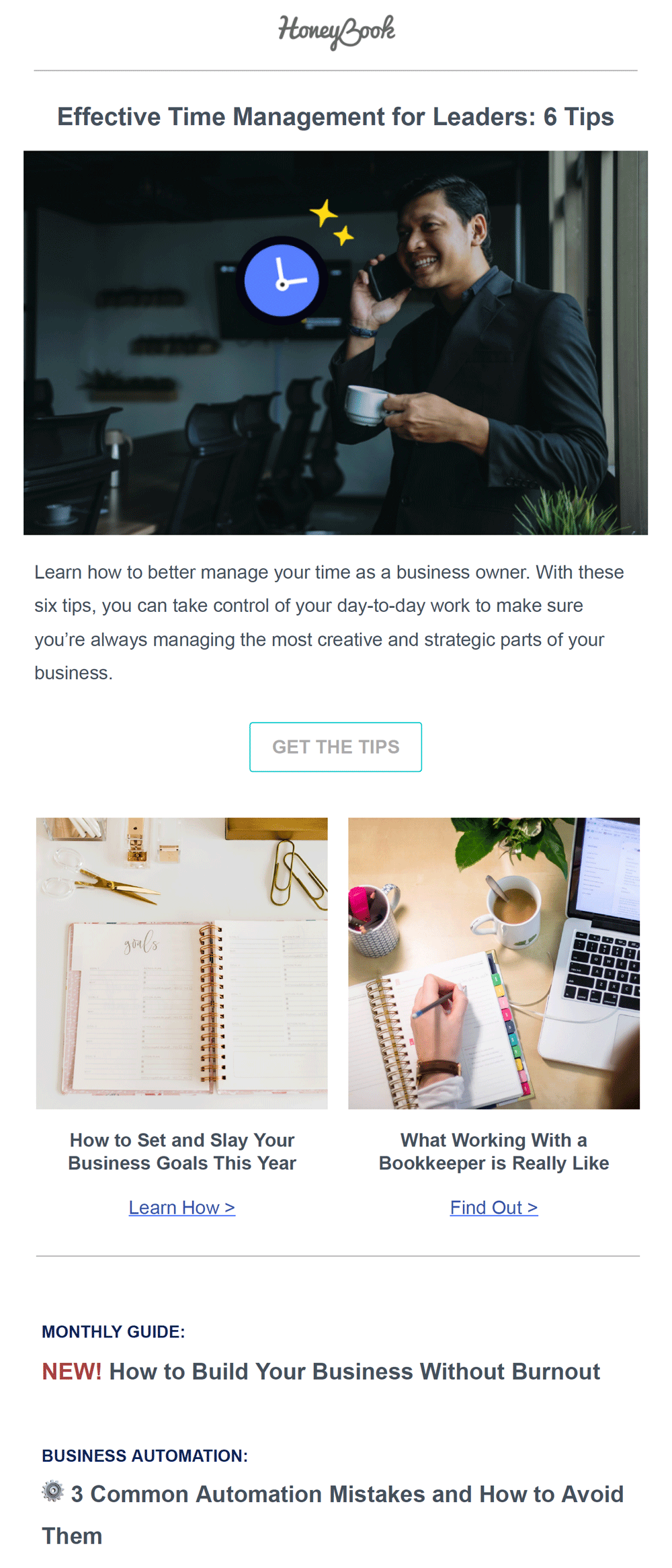
No matter what kind of curated content you're sending out, it won't matter if your email looks overpacked or messy once the reader opens it. It can be tempting to want to jam-pack a ton of links into these emails, but that will only leave you with an email that looks like it belongs on Hoarders. Stick with just a handful of links paired with large photos, larger font, and very few (if any) link descriptions.
HoneyBook's content roundup emails are super sparse, but in a way that I think most readers appreciate—I was able to give this email a quick scan and know right away whether I wanted to click through or close out.
7. Newsletter email: Mind Tools for Business
Buyer personas: Gatekeeper, User, Influencer
Journey stage: Consideration
Although they can be similar to curated content emails, newsletters give marketers a little more wiggle room to write. People know what newsletters are, so when they open them, they're doing so when they have a free moment to actually read what's inside it.
That said: quick, clean takeaways are still the surest pathway to newsletter success. Notice how Mind Tools for Business uses attention-grabbing headlines like "10 things managers should never say - and what to say instead" that quickly convey exactly what the reader will get out of the article.
Whether you're including links from news sites or modeling your own "headlines" after real news outlets, headlines can lend your newsletter a "must-know" tone of voice that will engage readers right away.
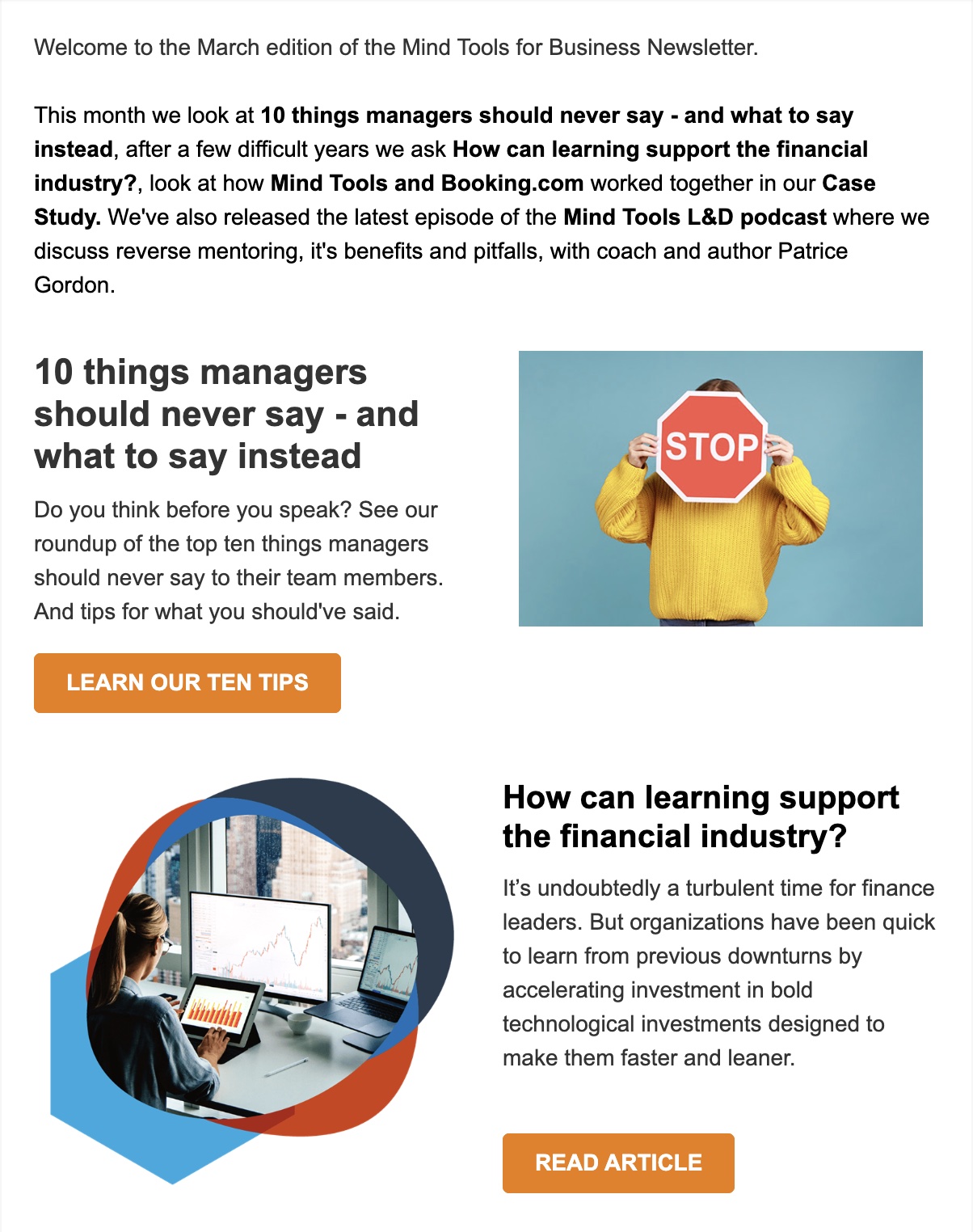
8. Release notes: Figma
Buyer personas: User, Influencer
Journey stage: Retention
Figma always kills it when it comes to design—even in their driest emails. This monthly release notes email is visually engaging right out of the gate, featuring beautiful colors, lots of free space, and a design that draws you right down the page. Never say design doesn't matter, even in a product update email. It's so pretty I almost didn't notice the apostrophe incident in the first paragraph.
They also serve you the most important information right up front in a conversational tone, which is respectful of the B2B professional's chronic time shortage. They go to the trouble of sharing the highlights first before getting into a video recap of the nitty-gritty that may or may not be relevant to every Figma user.

9. User newsletter: Zapier
Buyer personas: User, Influencer
Journey stage: Retention
A user newsletter's goal is to reinforce value and encourage deeper product adoption. These emails often highlight new features, provide practical tips and use cases, and showcase how users can maximize their experience with the platform.
Zapier's user newsletter focuses on showing, not telling. It's a short-and-sweet showcase of new step-by-step guides for automating specific workflows, updates to products like Interfaces, and detailed walkthroughs for complex business processes. Also, it's notably sent on a predictable (monthly) cadence, so as not to clog inboxes.

Automate your B2B email marketing campaigns
B2B email marketing is undeniably tricky, but taking time to do it right pays off. AI automation and workflow orchestration from Zapier can help you get to the top of it with powerful automatic workflows that can connect and configure all your favorite apps, with a boost from AI.
Imagine new CRM contacts automatically enrolling in targeted email sequences, or engagement in your emails triggering updates in your CRM—that's the power of automation and AI in email marketing. Learn more about the power of email campaign automations.
B2B email marketing FAQ
What is email marketing in B2B?
Email marketing in B2B is all about connecting with professionals directly through their inboxes. You're not selling to just anyone; in B2B, you build relationships, share valuable info, and show the people who work for the businesses you're selling to how your product or service can help them do their jobs better.
What are the four types of B2B marketing?
The four main types of B2B marketing are content marketing, account-based marketing (ABM), inbound marketing, and outbound marketing. Each of these types of B2B marketing plays a different role in getting the word out about your service and building those crucial business connections. Email can be an integral part of both inbound and outbound marketing strategies, depending on its application.
How effective is B2B email marketing?
B2B email marketing is still a powerhouse. According to the Content Marketing Institute, 42% of B2B marketers identified email as their most effective distribution channel in 2024. It lets you talk straight to the right people with messages tailored just for them, guiding them gently but inexorably toward a sale.
What is the 80/20 rule in email marketing?
The 80/20 rule in email marketing suggests that approximately 80% of your email content should focus on providing value to your audience through educational materials, helpful resources, industry insights, and relationship-building content, while the remaining 20% can be dedicated to promotional content like deals.
Related reading:
This article was originally published in April 2022 and has also had contributions from Luke Strauss and Abigail Sims. The most recent update was in April 2025.





